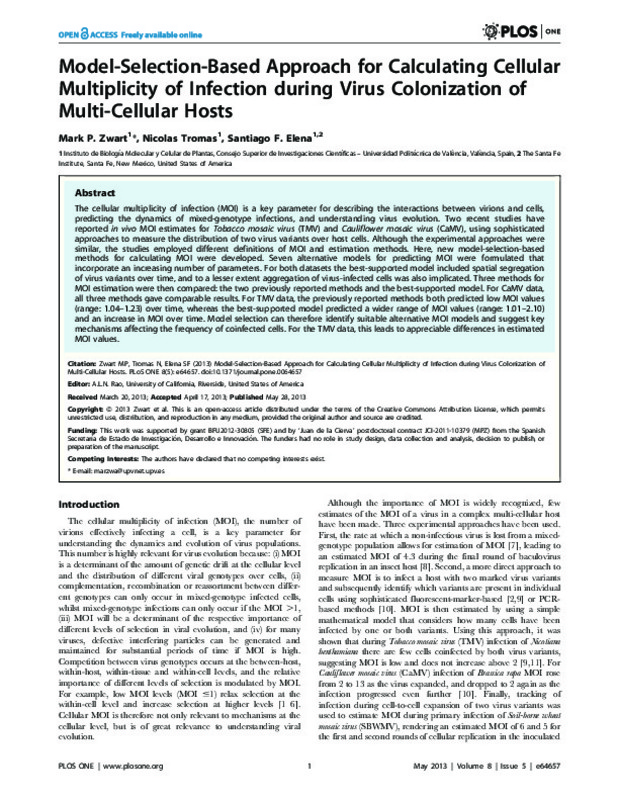Froissart, R., Wilke, C. O., Montville, R., Remold, S. K., Chao, L., & Turner, P. E. (2004). Co-infection Weakens Selection Against Epistatic Mutations in RNA Viruses. Genetics, 168(1), 9-19. doi:10.1534/genetics.104.030205
Miyashita, S., & Kishino, H. (2009). Estimation of the Size of Genetic Bottlenecks in Cell-to-Cell Movement of Soil-Borne Wheat Mosaic Virus and the Possible Role of the Bottlenecks in Speeding Up Selection of Variations in trans-Acting Genes or Elements. Journal of Virology, 84(4), 1828-1837. doi:10.1128/jvi.01890-09
Taylor, D. R., Zeyl, C., & Cooke, E. (2002). Conflicting levels of selection in the accumulation of mitochondrial defects inSaccharomycescerevisiae. Proceedings of the National Academy of Sciences, 99(6), 3690-3694. doi:10.1073/pnas.072660299
[+]
Froissart, R., Wilke, C. O., Montville, R., Remold, S. K., Chao, L., & Turner, P. E. (2004). Co-infection Weakens Selection Against Epistatic Mutations in RNA Viruses. Genetics, 168(1), 9-19. doi:10.1534/genetics.104.030205
Miyashita, S., & Kishino, H. (2009). Estimation of the Size of Genetic Bottlenecks in Cell-to-Cell Movement of Soil-Borne Wheat Mosaic Virus and the Possible Role of the Bottlenecks in Speeding Up Selection of Variations in trans-Acting Genes or Elements. Journal of Virology, 84(4), 1828-1837. doi:10.1128/jvi.01890-09
Taylor, D. R., Zeyl, C., & Cooke, E. (2002). Conflicting levels of selection in the accumulation of mitochondrial defects inSaccharomycescerevisiae. Proceedings of the National Academy of Sciences, 99(6), 3690-3694. doi:10.1073/pnas.072660299
Turner, P. E., & Chao, L. (1999). Prisoner’s dilemma in an RNA virus. Nature, 398(6726), 441-443. doi:10.1038/18913
Turner, P. E., & Chao, L. (2003). Escape from Prisoner’s Dilemma in RNA Phage Φ6. The American Naturalist, 161(3), 497-505. doi:10.1086/367880
Zwart, M. P., Erro, E., van Oers, M. M., de Visser, J. A. G. M., & Vlak, J. M. (2008). Low multiplicity of infection in vivo results in purifying selection against baculovirus deletion mutants. Journal of General Virology, 89(5), 1220-1224. doi:10.1099/vir.0.83645-0
Godfray, H. C. J., O’reilly, D. R., & Briggs, C. J. (1997). A model of Nucleopolyhedrovirus (NPV) population genetics applied to co–occlusion and the spread of the few Polyhedra (FP) phenotype. Proceedings of the Royal Society of London. Series B: Biological Sciences, 264(1380), 315-322. doi:10.1098/rspb.1997.0045
Bull, J. C., Godfray, H. C. J., & O’Reilly, D. R. (2001). Persistence of an Occlusion-Negative Recombinant Nucleopolyhedrovirus in Trichoplusia ni Indicates High Multiplicity of Cellular Infection. Applied and Environmental Microbiology, 67(11), 5204-5209. doi:10.1128/aem.67.11.5204-5209.2001
Gonzalez-Jara, P., Fraile, A., Canto, T., & Garcia-Arenal, F. (2009). The Multiplicity of Infection of a Plant Virus Varies during Colonization of Its Eukaryotic Host. Journal of Virology, 83(15), 7487-7494. doi:10.1128/jvi.00636-09
Gutiérrez, S., Yvon, M., Thébaud, G., Monsion, B., Michalakis, Y., & Blanc, S. (2010). Dynamics of the Multiplicity of Cellular Infection in a Plant Virus. PLoS Pathogens, 6(9), e1001113. doi:10.1371/journal.ppat.1001113
Morra, M. R., & Petty, I. T. D. (2000). Tissue Specificity of Geminivirus Infection Is Genetically Determined. The Plant Cell, 12(11), 2259-2270. doi:10.1105/tpc.12.11.2259
Silva, M. S., Goldbach, R. W., van Lent, J. W. M., & Wellink, J. (2002). Phloem loading and unloading of Cowpea mosaic virus in Vigna unguiculata. Journal of General Virology, 83(6), 1493-1504. doi:10.1099/0022-1317-83-6-1493
Sokal RR, Rohlf FJ (1995) Biometry, 3rd edition. New York: W.H. Freeman and Co. 887 p.
Zwart, M. P., Hemerik, L., Cory, J. S., de Visser, J. A. G. M., Bianchi, F. J. J. A., Van Oers, M. M., … Van der Werf, W. (2009). An experimental test of the independent action hypothesis in virus–insect pathosystems. Proceedings of the Royal Society B: Biological Sciences, 276(1665), 2233-2242. doi:10.1098/rspb.2009.0064
Dietrich, C. (2003). Fluorescent labelling reveals spatial separation of potyvirus populations in mixed infected Nicotiana benthamiana plants. Journal of General Virology, 84(10), 2871-2876. doi:10.1099/vir.0.19245-0
Zwart, M. P., Daròs, J.-A., & Elena, S. F. (2011). One Is Enough: In Vivo Effective Population Size Is Dose-Dependent for a Plant RNA Virus. PLoS Pathogens, 7(7), e1002122. doi:10.1371/journal.ppat.1002122
Lafforgue, G., Tromas, N., Elena, S. F., & Zwart, M. P. (2012). Dynamics of the Establishment of Systemic Potyvirus Infection: Independent yet Cumulative Action of Primary Infection Sites. Journal of Virology, 86(23), 12912-12922. doi:10.1128/jvi.02207-12
Dolja, V. V., McBride, H. J., & Carrington, J. C. (1992). Tagging of plant potyvirus replication and movement by insertion of beta-glucuronidase into the viral polyprotein. Proceedings of the National Academy of Sciences, 89(21), 10208-10212. doi:10.1073/pnas.89.21.10208
Van der Werf, W., Hemerik, L., Vlak, J. M., & Zwart, M. P. (2011). Heterogeneous Host Susceptibility Enhances Prevalence of Mixed-Genotype Micro-Parasite Infections. PLoS Computational Biology, 7(6), e1002097. doi:10.1371/journal.pcbi.1002097
Barlow, N. D. (1991). A Spatially Aggregated Disease/Host Model for Bovine Tb in New Zealand Possum Populations. The Journal of Applied Ecology, 28(3), 777. doi:10.2307/2404207
Barlow, N. D. (2000). Non-linear transmission and simple models for bovine tuberculosis. Journal of Animal Ecology, 69(4), 703-713. doi:10.1046/j.1365-2656.2000.00428.x
R Core Team (2012) R: A Language and Environment for Statistical Computing. Vienna: R Foundation for Statistical Computing.
Olkin I, Gleser LJ, Derman C. (1994) Probability Models and Applications, 2nd ed. New York: Macmillan. 575 p.
[-]








